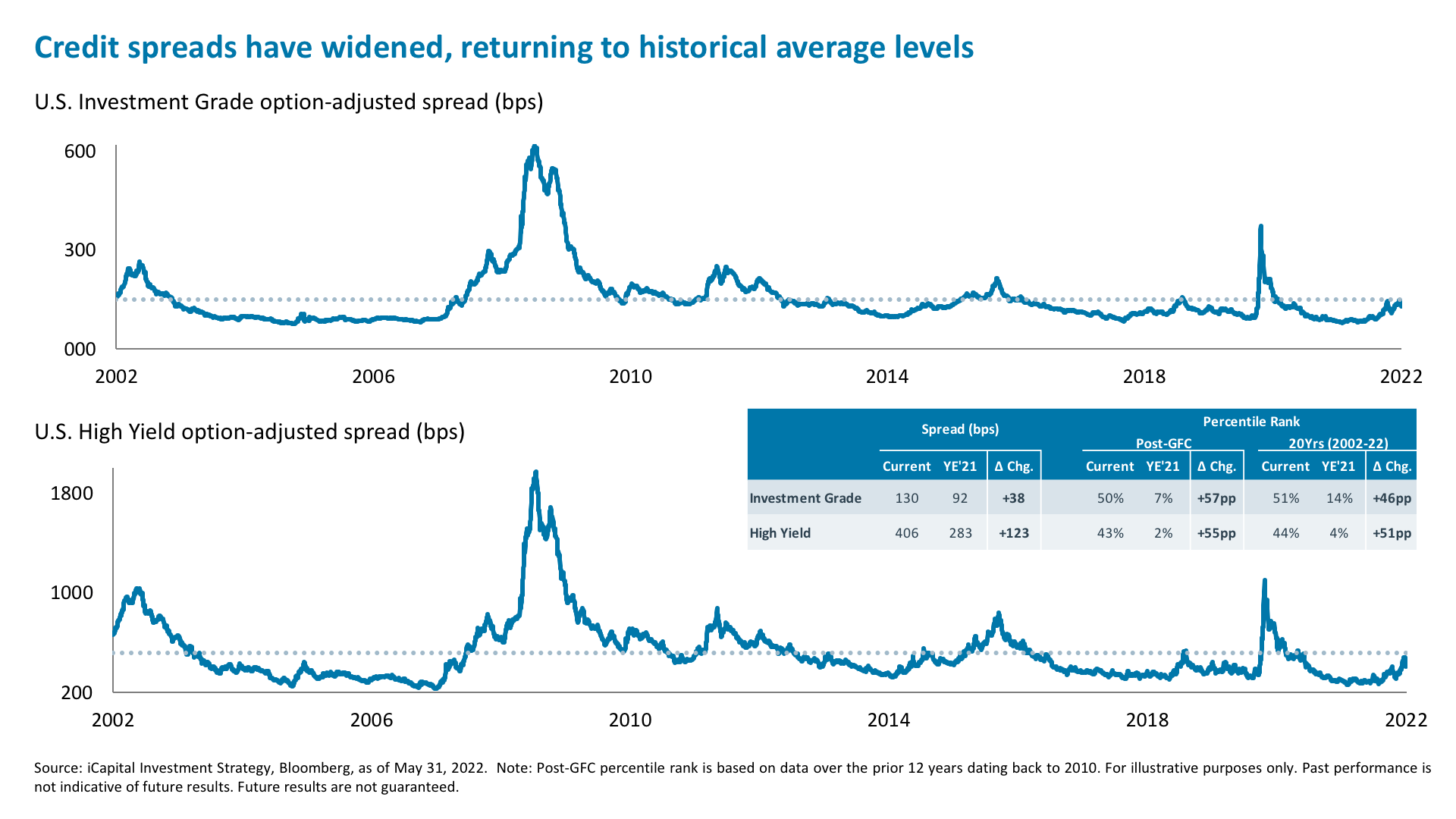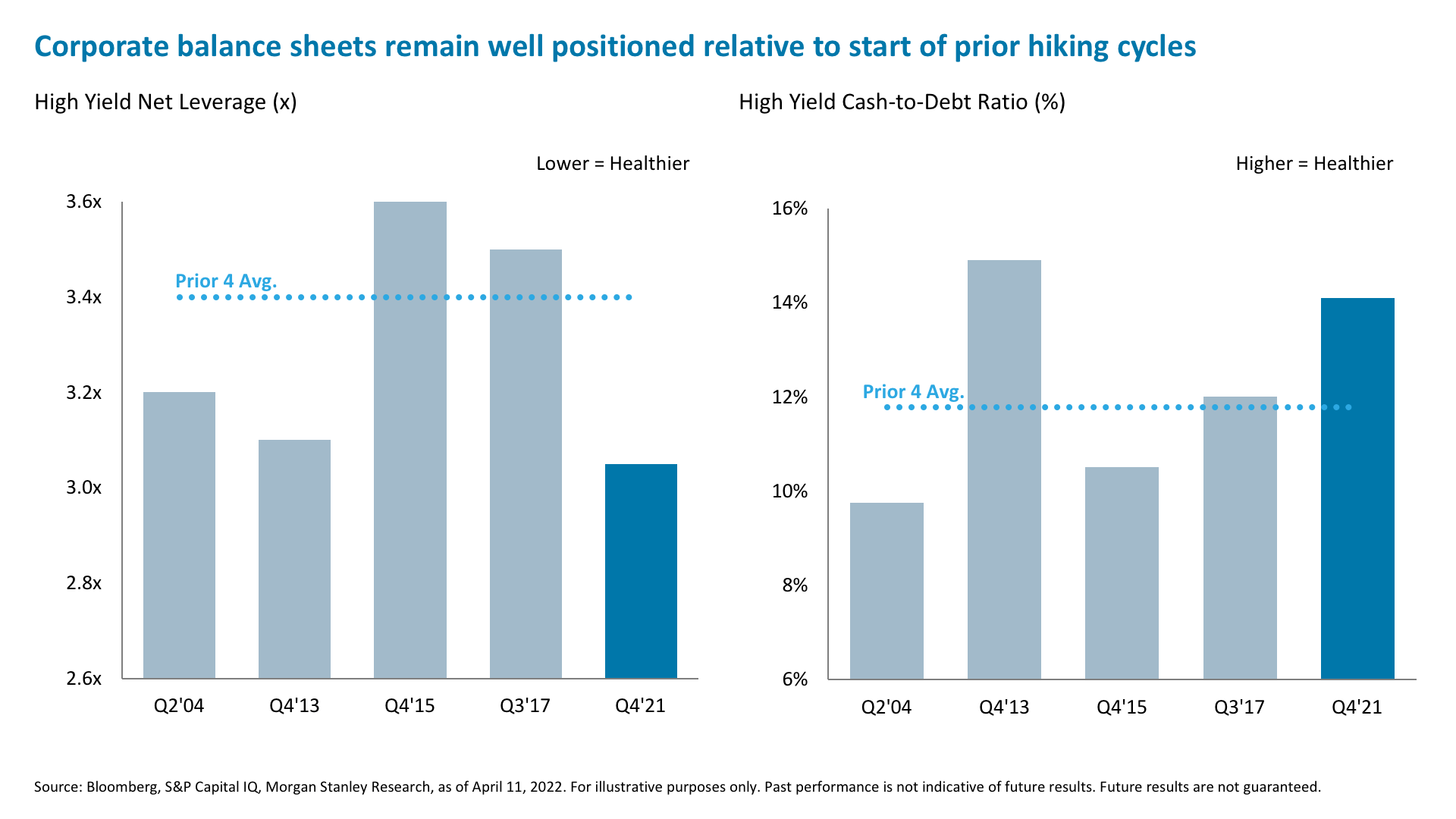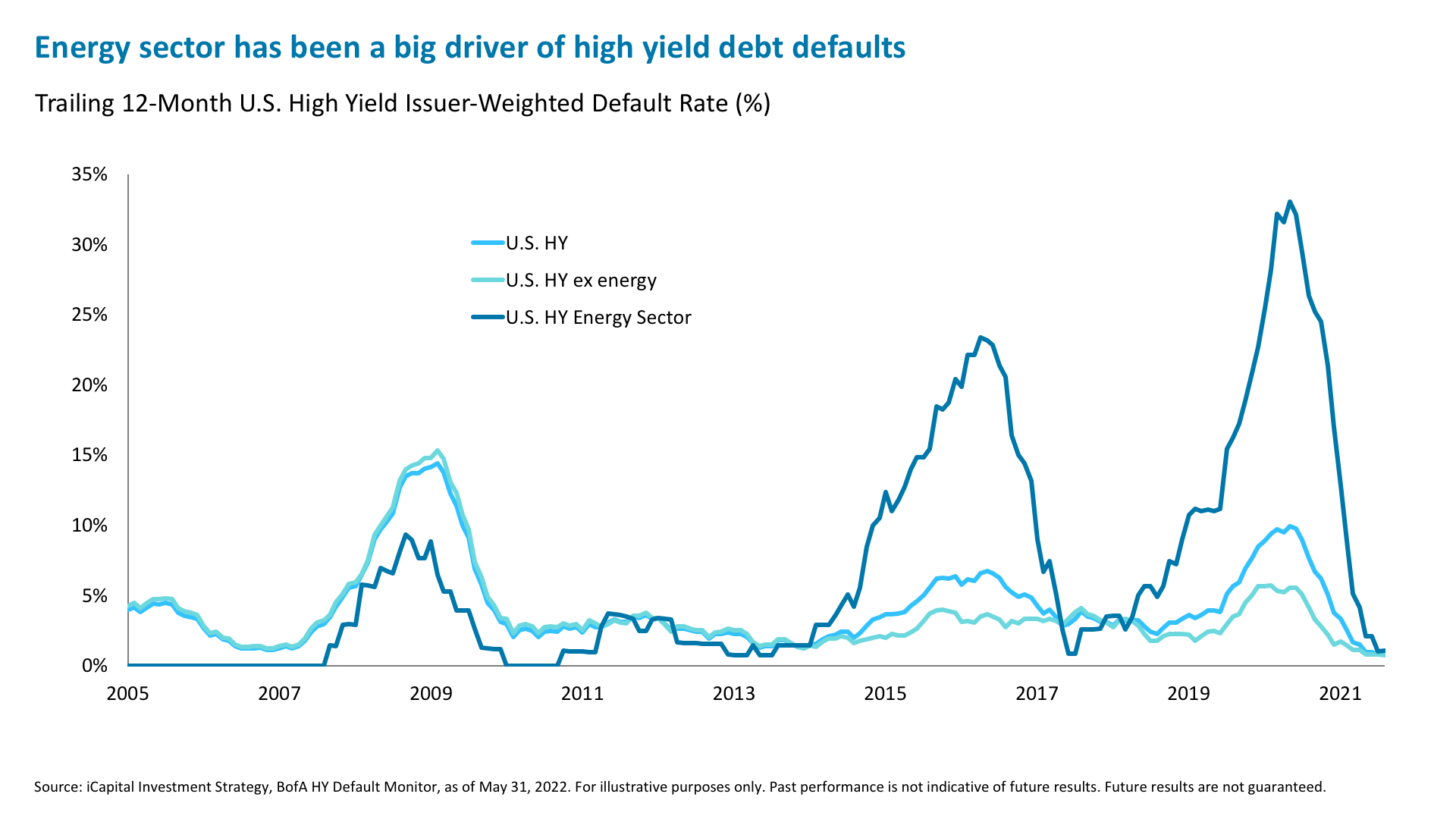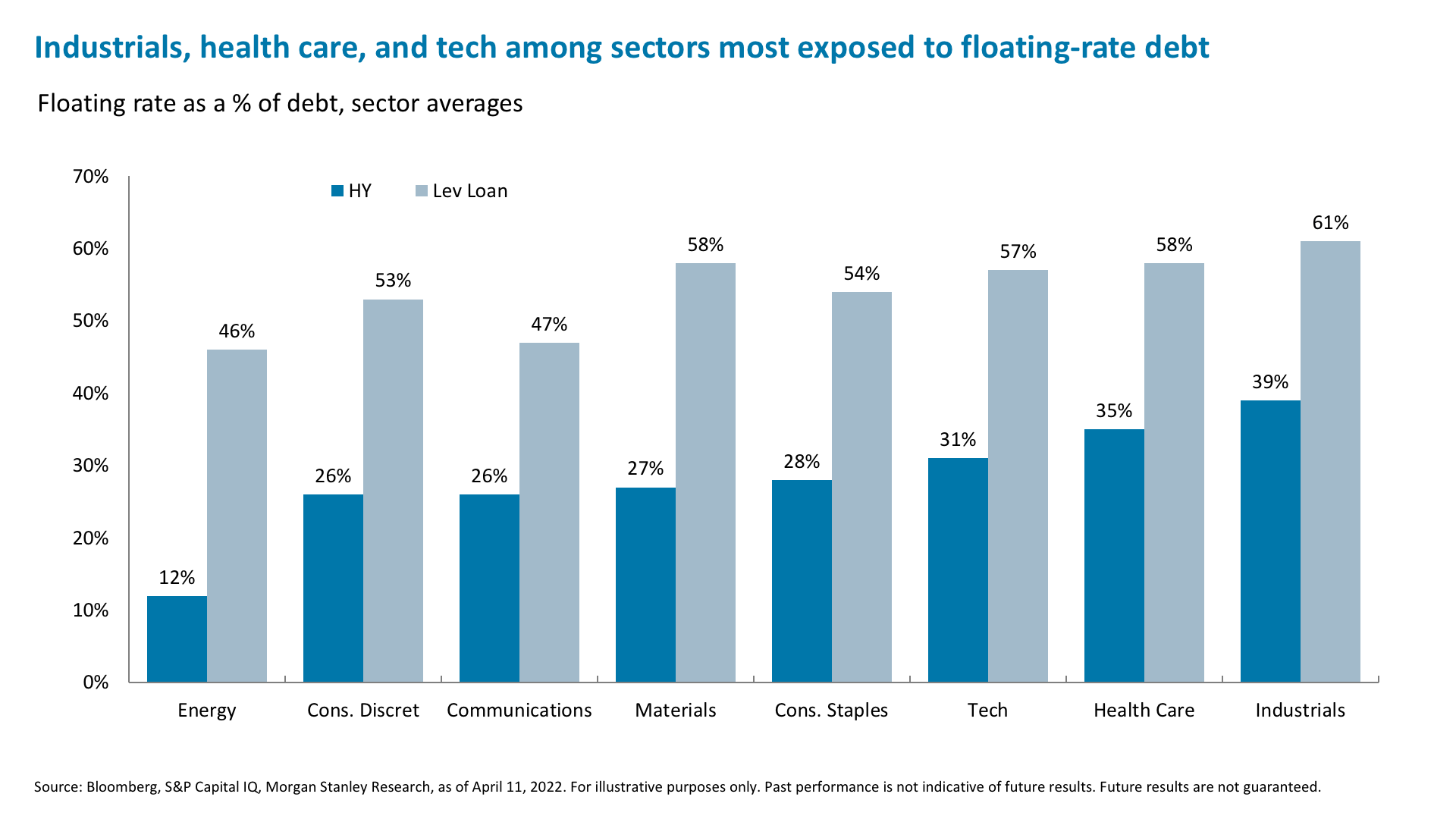In recent weeks, as equities whipsawed, rates rose, and credit spreads widened, one question has kept coming up—how concerned should investors be about default risk in credit, especially among issuers that took on a lot of floating-rate debt?
In this week’s commentary, we look at the key metrics of health in high yield debt and leveraged loans. Bottom line—a slower economy and rising rates are sure to pinch some issuers, but by and large we believe strong corporate fundamentals and higher margins in sectors that relied on floating-rate debt should mitigate a surge in defaults.
Less about credit quality, more about macro sentiment
On the back of U.S. Federal Reserve (Fed) tightening and the accompanying rate volatility, credit markets have seen the greatest spread widening since 2020. So far this year, the spread on U.S. investment grade corporates (IG Corps) has widened 38bps to 130bps, with high yield (HY) and leveraged loan (Lev Loan) spreads also widening.1 A net 55% of IG and net 68% of HY investors expect spreads to widen further in the coming months.2 That said, spreads remain significantly below levels associated with recessions.3 For HY, for example, spreads would need to widen another 400bps to roughly 800bps before flashing a recessionary signal.4
Furthermore, distress ratios remain low. The HY distress ratio—the percentage of HY bonds with spreads above 1000bps—is currently at 5%, in line with historical averages.5 The lev loans distress ratio—defined as loans priced below $80—has risen slightly to 1.6% from 1.5% at the beginning of the year but is still well below its longer-run average of 3.5%.6
With distress ratios still subdued, it seems clear that the current movement across the credit market is less about deteriorating credit quality and more a reflection of macro risk-off sentiment. Current default rates for HY and Lev Loans are just 0.8%7 and 0.5%8, respectively, and are forecast to rise only mildly to 1.25% and 1.75% in 20239. For context, the aggregate trailing twelve-month (TTM) issuer-weighted corporate HY default rate in the United States has averaged 4.2% since 1998 and 3.7% in the post-Global Financial Crisis (GFC) period.10
Starting from a position of strength
Although corporate credit quality is likely at or past its peak as the economy is poised to slow, U.S. corporates remain in one of their strongest financial positions of the past two decades, especially compared to the start of prior tightening cycles.11 Net leverage has materially declined while coverage ratios are at post-GFC peaks.12 Leverage ratios, both in the HY and leveraged loan space, have declined to decade lows with median net leverage ratios at 3.05x and 3.69x, respectively.13 Simultaneously, median interest coverage ratios for HY and leveraged loans have improved, and sit at 5.09x and 4.99x, respectively, and this improvement in coverage ratios has been broad-based.14
Additionally, looking at the composition of the index, HY debt quality has improved. Currently, the ICE BofA High Yield Index is 53% BB-rated bonds, 37% single-Bs, and 10% CCCs.15 In the GFC-era less than 40% of the HY space was BB rated, with nearly 30% CCC or lower.16 These credit quality improvements may help moderate defaults at the index level: BB-rated bonds had an average annual default rate of 0.63% from 1981 to 2020, versus 28.30% for CCC-rated bonds.17 Similarly, the quality of the lev loans market has also improved, with 27% of the S&P/LSTA Leveraged Loan Index now rated B-, up from 9% five years ago.18
Moreover, energy represents 13% of the ICE BofA High Yield Index. Energy has been a primary driver of HY defaults. Of the $280bn in HY defaults in the last decade, $110bn, or roughly 40%, were in the energy sector.19 By stripping out energy from the broader HY market the average TTM issuer-weighted default rate falls from 4.49% to 2.95%.20
Capacity exists to absorb higher interest rates
Despite stronger credit fundamentals, one area of concern is companies that have accrued a lot of floating-rate debt, more an attribute of the lev loan market than the HY market. Collectively, gross issuance for the U.S. leveraged loan and high yield markets has been $10.1 trillion since 2009, with leveraged loan issuance eclipsing HY by 50%.21 Within this segment of the market, the sectors with the highest degree of floating-rate liabilities as a percentage of total debt include industrials, health care, materials, and tech.22 The question then becomes, can these companies weather the additional 197 bps of Fed rate increases implied by the futures curve through year-end?23
At the index level, assuming rates rise 250bps, the coverage ratio for the index drops from 3.9x to 2.3x.24 However, this rules out the possibility that companies have hedged their floating-rate liabilities, which many likely have. Bottom line, with net interest rate margins across sectors near record highs and earnings still expected to grow 10.1% in both 2022 and 202325, companies, as a whole, should have the financial capacity to absorb these higher costs.
At an industry level, broadcasting, energy, and gaming & lodging seem most exposed, with coverage ratios likely to drop below 2x, but the rest of the sectors would remain above 2x.26 Information technology and health care specifically boast well-above-benchmark margins, helping offset floating-rate concerns. For the materials sector, the 32.5% surge in commodity prices year-to-date should help offset the impact of rising rates.27 Still, the combination of rising rates and slowing earnings growth should be watched closely.
Though data suggests strength, a move up in credit quality could be prudent
Overall, despite the recent spread widening, we see default risk remaining relatively benign from a historical context, though pockets of stress are likely to emerge.
When looking for these stress points, it will be important to monitor the evolving macro backdrop, which is currently dominated by the specter of ongoing rate hikes and a potential growth slowdown. Should rate rises continue to the upper range of expectations and/or demand fall more sharply than expected industries with weaker fundamentals and elevated, unhedged floating-rate liabilities may become more vulnerable. While debt metrics currently suggest borrowers are entering this period from a position of relative strength, cautious investors may want to consider shifting up the debt spectrum to less risky assets.
1. Bloomberg, iCapital Investment Strategy, as of May 31, 2022.
2. BofA US Credit Investor Survey, as of May 12, 2022.
3. Bloomberg, iCapital Investment Strategy, as of May 31, 2022.
4. Bloomberg, Morgan Stanley, US Credit Strategy Mid-Year Outlook, as of May 19, 2022.
5. Bloomberg, iCapital Investment Strategy, as of May 31, 2022.
6. S&P Global, LCD, as of May 2, 2022.
7. BofA HY Default Monitor, as of May 3, 2022.
8. Fitch, as of May 11, 2022.
9. JPMorgan, as of April 19, 2022.
10. iCapital Investment Strategy, BofA HY Default Monitor, as of May 3, 2022.
11. Bloomberg, Morgan Stanley, Goldman Sachs, iCapital Investment Strategy, as of May 2022.
12. Goldman Sachs, as of March 22, 2022.
13. Morgan Stanley, as of April 11, 2022.
14. Morgan Stanley, Goldman Sachs, as of April 11, 2022.
15. BofA, as of May 27, 2022.
16. Bloomberg, as of May 31, 2022.
17. S&P Global Annual Global Corporate Default And Rating Transition Study, as of April 7, 2021.
18. S&P Global, LCD, as of April 30, 2022.
19. BofA High Yield Market Primer, as of May 27, 2022.
20. iCapital Investment Strategy, BofA HY Default Monitor, as of May 27, 2022.
21. JPMorgan Credit Research, April 19, 2022.
22. Morgan Stanley, US Credit Strategy Mid-Year Outlook, as of May 19, 2022.
23. Bloomberg, as of May 31, 2022.
24. JPMorgan Credit Research, April 19, 2022.
25. FactSet, as of May 27, 2022.
26. JPMorgan Credit Research, April 19, 2022.
27. Bloomberg, as of May 31, 2022.
IMPORTANT INFORMATION
The material herein has been provided to you for informational purposes only by iCapital, Inc. (“iCapital”). This material is the property of iCapital and may not be shared without the written permission of iCapital. No part of this material may be reproduced in any form, or referred to in any other publication, without express written permission of iCapital.
This material is provided for informational purposes only and is not intended as, and may not be relied on in any manner as, legal, tax or investment advice, a recommendation, or as an offer to sell, a solicitation of an offer to purchase or a recommendation of any interest in any fund or security. You should consult your personal accounting, tax and legal advisors to understand the implications of any investment specific to your personal financial situation. This material does not intend to address the financial objectives, situation or specific needs of any individual investor. Alternative investments are complex, speculative investment vehicles and are not suitable for all investors.
The information contained herein is an opinion only, as of the date indicated, and should not be relied upon as the only important information available. Any prediction, projection or forecast on the economy, stock market, bond market or the economic trends of the markets is not necessarily indicative of the future or likely performance. The information contained herein is subject to change, incomplete, and may include information and/or data obtained from third party sources that iCapital believes, but does not guarantee, to be accurate. iCapital considers this third-party data reliable, but does not represent that it is accurate, complete and/or up to date, and it should not be relied on as such. iCapital makes no representation as to the accuracy or completeness of this material and accepts no liability for losses arising from the use of the material presented. No representation or warranty is made by iCapital as to the reasonableness or completeness of such forward-looking statements or to any other financial information contained herein.
Securities products and services are offered by iCapital Markets, an SEC-registered broker-dealer, member FINRA and SIPC, and an affiliate of iCapital, Inc. and Institutional Capital Network, Inc. These registrations and memberships in no way imply that the SEC, FINRA, or SIPC have endorsed any of the entities, products, or services discussed herein. Annuities and insurance services are provided by iCapital Annuities and Insurance Services LLC, an affiliate of iCapital, Inc. “iCapital” and “iCapital Network” are registered trademarks of Institutional Capital Network, Inc. Additional information is available upon request.
© 2023 Institutional Capital Network, Inc. All Rights Reserved.





















